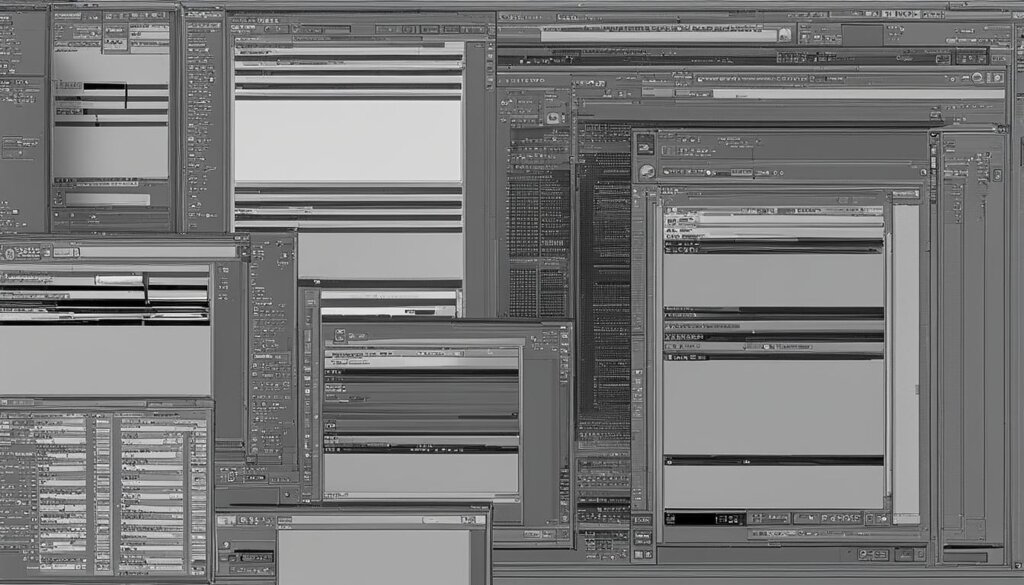Table of Contents
Welcome to our comprehensive guide on virtual memory and its importance in computer systems. In this article, we will delve into the concept of virtual memory, its role in memory management, and its impact on system performance while running multitasking or large programs.
Virtual memory is a crucial technique employed by computer operating systems to address the limitations of main memory (RAM) and ensure optimized performance. It allows the use of secondary memory, such as disk storage, as if it were part of the main memory. This flexibility enables efficient multitasking and the execution of memory-intensive applications.
However, virtual memory operates at a slower speed compared to RAM, which can affect the overall performance of the system. Excessive swapping between virtual memory and RAM can result in a phenomenon known as “thrashing,” where the system slows down due to frequent data transfers between the two memory types.
Throughout this article, we will explore the inner workings of virtual memory, how it works in conjunction with the operating system, and the various techniques used for memory management. Additionally, we will discuss the benefits and limitations of virtual memory, as well as the differences between virtual and physical memory.
Let’s delve deeper into the world of virtual memory and discover how it revolutionizes memory management and enhances system performance.
What is Virtual Memory and How Does it Work?
Virtual memory is a crucial component of memory management in modern computer systems. It combines both hardware and software elements to optimize memory utilization and improve system performance. Understanding how virtual memory works is essential for comprehending its benefits and limitations.
When a program is running, the data associated with that program is stored in the computer’s main memory, known as RAM (Random Access Memory). The RAM provides fast and temporary storage for the program and its data, allowing the computer’s processor to quickly access and manipulate the information.
A key component of virtual memory is the Memory Management Unit (MMU), which plays a vital role in the memory management process. The MMU maps logical addresses, which are generated by programs, to the corresponding physical addresses in the RAM. This mapping enables the program to access the data stored in the RAM based on the logical address.
However, RAM is limited in size, and when it becomes full, the operating system must manage the memory efficiently to ensure optimal performance. Here’s where virtual memory comes into play. When the RAM space is needed for other purposes, the operating system, through a memory manager, swaps out less frequently used data from RAM and transfers it to secondary storage, such as a hard drive. This secondary storage serves as an extension of the RAM, allowing the computer to store data that is not currently in use. The process of moving data between RAM and secondary storage is known as swapping.
Virtual memory works by translating logical addresses into physical addresses when data needs to be accessed from the secondary storage and brought back into RAM. The MMU facilitates this translation, ensuring that the program can retrieve the data it needs from the virtual memory seamlessly. This translation process is performed transparently by the operating system, hidden from the program itself.
By utilizing virtual memory, the computer can effectively manage its resources and run multiple programs simultaneously. It allows for efficient memory allocation, enabling larger programs to be executed without the need for extensive physical memory. Virtual memory also provides memory protection and isolation, ensuring that each program operates within its allocated address space and cannot access the memory of other programs.
To illustrate the concept of virtual memory, here’s an image that depicts the relationship between the physical and virtual addresses:
Types of Virtual Memory
Virtual memory can be managed through different techniques. In most computers, the Memory Management Unit (MMU) hardware is integrated into the CPU, and virtual memory is either paged or segmented.
Paging
Paging divides memory into sections called pages. When the RAM is full, unused pages are transferred to the hard drive using a swap file. This technique allows for efficient use of physical memory by storing data that is not actively being used.
Page tables are used to translate virtual addresses into physical addresses. These tables keep track of the mapping between virtual memory pages and physical memory frames. When a program references a virtual address, the MMU retrieves the corresponding physical address from the page table.
Page fault exceptions may occur when a requested virtual memory page is not present in physical memory. In such cases, the operating system must fetch the required page from the hard drive into physical memory before allowing the program to access it.

Segmentation
Segmentation divides virtual memory into segments of different lengths. Each segment represents a logical unit, such as a code segment, data segment, or stack segment. A segment table is used to track these segments and their corresponding base addresses.
When a program references a virtual address, the MMU uses the segment table to determine the base address of the corresponding segment. The MMU then adds the offset from the virtual address to the base address to determine the physical address.
By combining paging and segmentation, memory can be organized into frames or pages and segments. This allows for more efficient memory management and flexibility in handling different types of workloads.
Overall, understanding the different types of virtual memory and their management techniques is crucial for optimizing memory usage and improving system performance.
Benefits of Using Virtual Memory
The advantages of using virtual memory are significant. By implementing virtual memory, memory management becomes more efficient, allowing for increased memory capacity and the ability to run multiple processes simultaneously. This is particularly beneficial when dealing with larger applications that require more memory.
Virtual memory also provides memory isolation, ensuring that each program operates within its own address space. This not only enhances security but also prevents interference between different programs.
One of the key benefits of virtual memory is its cost-effectiveness. Instead of investing in expensive physical memory upgrades, virtual memory allows for the utilization of secondary storage, such as a hard drive, as an extension of the main memory. This enables the execution of larger applications without the need for extensive physical memory expansion.
Another advantage of virtual memory is that it eliminates the problem of external fragmentation. With virtual memory, there is no need for continuous allocation and deallocation of memory blocks, as the system handles the translation between virtual addresses and physical addresses seamlessly.
Furthermore, virtual memory optimizes CPU utilization by efficiently managing data movement between physical memory and secondary storage. Data can be swapped in and out of memory as needed, reducing unnecessary data movements and minimizing delays in program execution.
Additionally, virtual memory allows for the sharing of pages among processes. This means that multiple processes can access the same memory pages, reducing the need for duplicate data storage and improving overall system efficiency.
Overall, the benefits of using virtual memory include increased memory capacity, support for multiprogramming, memory isolation, the ability to run larger applications, cost-effectiveness, no fragmentation, optimized CPU utilization, efficient data movement, and shared pages.
“Virtual memory enhances memory management, enabling efficient use of memory resources, improved system performance, and seamless execution of larger applications.”
Image alt text: virtual memory
Limitations of Using Virtual Memory
While virtual memory offers several benefits, it also comes with its limitations. These limitations can impact system performance, address translation, and the overall virtual storage size. Understanding these limitations is crucial for effective memory management and optimizing system performance.
1. System Performance
One of the main limitations of virtual memory is the potential reduction in system performance. This is primarily due to the time required for data transfer between the physical memory (RAM) and the hard drive. Whenever data needs to be accessed from virtual memory, it must be swapped between RAM and the hard drive, leading to increased latency and slower performance.
2. Address Translation
Address translation is another aspect that can impact the performance of virtual memory. Converting virtual addresses to physical addresses involves additional processing and translation overhead, which can result in slower performance and increased system resource utilization.
3. Virtual Storage Size
The size of the virtual storage can also be a limiting factor when using virtual memory. The total amount of virtual memory available is determined by the size of the hard drive or secondary storage. Insufficient virtual storage can restrict the ability to run large applications or multiple processes simultaneously, affecting overall system performance and multitasking capabilities.
4. Thrashing
Thrashing is a phenomenon that can occur when there is not enough physical memory (RAM) available to meet the demands of running programs. When the system constantly swaps pages between RAM and the hard drive, performance significantly degrades. This continuous swapping, known as thrashing, results in decreased efficiency and overall system slowdown.
5. Application Switching
In a virtual memory system, switching between applications may take longer compared to a system with ample physical memory. This is because the operating system needs to manage the swapping of application data in and out of virtual memory, leading to increased latency and potential delays in application responsiveness.
6. Hard Drive Space
Virtual memory requires additional hard drive space to accommodate the data being swapped between RAM and the hard drive. This can lead to increased disk space utilization, potentially limiting the available storage for other applications or files.
7. Difference from RAM
Virtual memory differs significantly from physical memory (RAM) in terms of speed and limitations. While virtual memory allows for larger storage capacities, it is considerably slower compared to RAM. Virtual memory also has limitations on the maximum size of individual processes and the total system memory available.
To better understand the limitations of virtual memory, here is a table summarizing the key points:
| Limitations | Impact |
|---|---|
| System Performance | Slower data transfer between RAM and hard drive, increased latency |
| Address Translation | Additional processing overhead, slower performance |
| Virtual Storage Size | Restrictions on running large applications or multiple processes |
| Thrashing | Decreased efficiency and system slowdown due to excessive swapping |
| Application Switching | Potential delays in switching between applications |
| Hard Drive Space | Increased disk space utilization, potentially limiting available storage |
| Difference from RAM | Slower speed, limitations on maximum process size and system memory |
It is essential to consider these limitations when implementing and managing virtual memory to ensure optimal system performance and memory utilization.
Virtual Memory vs. Physical Memory
Virtual memory and physical memory are two distinct concepts essential for understanding memory management in a computer system. Let’s explore the differences and how they work together.
Virtual memory is an illusionary memory space that allows larger applications to run by utilizing secondary storage, such as a hard drive. It serves as an extension of the RAM (Random Access Memory) and is managed by the operating system. When accessing virtual memory addresses, the CPU triggers a CPU exception, leading to memory swapping between RAM and secondary storage to accommodate data.
Physical memory, on the other hand, refers to the actual RAM installed in a computer. It is faster than virtual memory in terms of access speed. Physical memory addresses are directly shared among processes, and there is no need for memory swapping like in virtual memory. The CPU accesses physical memory directly without triggering exceptions.
Virtual Memory vs. Physical Memory: A Comparison
| Virtual Memory | Physical Memory |
|---|---|
| Managed by the operating system | Installed RAM in the computer |
| Allows larger applications to run | Directly shared among processes |
| Addresses trigger CPU exceptions | CPU accesses memory directly |
| Uses secondary storage (e.g., hard drive) | Faster access speed |
| Enables memory sharing among processes | Limited in capacity |
In summary, virtual memory and physical memory play complementary roles in the overall system performance. Virtual memory extends the memory capacity, allowing larger applications to run by utilizing secondary storage, while physical memory provides faster access speed but is limited in capacity. Understanding the differences between these two concepts is crucial for effective memory management and optimizing system performance.
How to Manage Virtual Memory
Managing virtual memory is a crucial aspect of memory management, and it primarily falls under the responsibility of the operating system. By understanding different virtual memory management techniques, users can optimize system performance and memory utilization.
By default, the operating system allocates a certain amount of hard drive space for virtual memory. However, manual reset options are available for fine-tuning the virtual memory settings. When manually resetting virtual memory, it is essential to specify the minimum and maximum amount of hard drive space to avoid running out of RAM or wasting resources.
Different operating systems may have varying mechanisms for managing virtual memory. Therefore, it is essential to have a basic understanding of virtual memory management principles.
Virtual memory management allows for flexibility in allocating additional memory to virtual machines in a virtualized computing environment. This enhances both performance and management flexibility.
Benefits of Manual Reset
Manual reset options for virtual memory provide several benefits:
- Improved System Performance: Adjusting virtual memory settings can optimize system performance, ensuring efficient memory allocation and avoiding slowdowns.
- Customized Configuration: Manual reset allows users to tailor virtual memory settings to their specific needs, considering factors such as available hard drive space and RAM limitations.
- Resource Optimization: By specifying the minimum and maximum amount of hard drive space, users can avoid wasting resources or experiencing RAM shortages.
Expert Insight: “Properly managing virtual memory is essential for maintaining a stable and efficient operating system. Manual reset options provide users with the flexibility to fine-tune their virtual memory settings, enabling optimal performance and resource allocation.”
Virtual Memory Management Techniques
Virtual memory management involves employing various techniques to optimize memory utilization. Some common techniques include:
- Paging: Dividing memory into fixed-size pages and transferring unused pages between RAM and the hard drive.
- Segmentation: Dividing virtual memory into segments of varying lengths and tracking them in a segment table.
These techniques offer different advantages and can be combined to provide more efficient memory management and address space utilization.
Case Study: Virtual Memory Management with Linux
| Operating System | Virtual Memory Management Mechanism |
|---|---|
| Linux | Linux, being a versatile operating system, implements a demand-paged virtual memory management mechanism. |
The demand-paged mechanism in Linux ensures that only the required pages are loaded into physical memory, reducing unnecessary disk I/O and optimizing system performance. This makes Linux a popular choice for systems requiring efficient virtual memory management.
Image: Visual representation of virtual memory management (source: seowriting.ai)
By effectively managing virtual memory, users can ensure smooth operation of their systems, optimize resource utilization, and enhance overall performance. Understanding the fundamental principles and available management techniques is key to harnessing the full potential of virtual memory in modern computing environments.
Performance in Virtual Memory
A well-designed virtual memory system plays a crucial role in optimizing the performance of computer systems. Several factors influence the overall performance, such as the page fault rate, memory access time, and page fault service time.
The page fault rate represents how frequently a process needs data from virtual memory. A higher page fault rate can significantly impact system performance, as it involves swapping data between the main memory and secondary storage, such as a hard drive. The time it takes to handle page faults, known as the page fault service time, and the memory access time also contribute to the effective memory access time.
Efficient swapping and frame allocation algorithms are essential for optimizing performance. These algorithms dictate how data is moved between the main memory and secondary storage. Additionally, the choice of paging policies, including fetch, replacement, and placement policies, has a direct impact on the overall efficiency of virtual memory.
Moreover, effective management of logical partition workloads can maximize CPU utilization, ensuring efficient resource allocation. By carefully balancing the distribution of tasks, system performance can be significantly improved.
A carefully designed virtual memory system, incorporating appropriate frame allocation, paging policies, and efficient management of page faults and memory access, can enhance memory management and overall system performance, allowing for smooth and efficient multitasking and resource utilization.
FAQ
What is virtual memory and how does it work?
Virtual memory is a memory management technique that allows secondary memory to be used as if it were part of the main memory. It functions by temporarily transferring data from RAM to disk storage, freeing up space in the RAM for running multiple programs simultaneously or using large programs.
What are the types of virtual memory?
There are two main types of virtual memory: paging and segmentation. Paging divides memory into sections called pages, while segmentation divides virtual memory into segments. Both techniques can be combined to divide memory into frames or pages and segments.
What are the benefits of using virtual memory?
Using virtual memory allows for more efficient utilization of memory, enables more processes to run simultaneously, provides memory isolation for security purposes, facilitates running larger applications, is cost-effective compared to increasing physical memory, and optimizes CPU utilization.
What are the limitations of using virtual memory?
The performance of the system may be reduced due to the time required for data transfer between physical memory and the hard drive. Address translation and the size of virtual storage can also impact performance. Thrashing may occur when there is not enough RAM, and application switching may take longer in a virtual memory system. Additionally, virtual memory requires additional hard drive space and differs in speed and limitations from physical memory (RAM).
What is the difference between virtual memory and physical memory?
Virtual memory refers to an illusory memory that allows larger applications to run using secondary storage, while physical memory refers to the actual RAM installed in a computer. Virtual memory addresses are not shared among processes, and swapping between physical and virtual memory occurs as needed. The CPU accesses physical memory directly, without triggering exceptions.
How can virtual memory be managed?
Managing virtual memory is primarily the responsibility of the operating system. Default settings determine the amount of hard drive space allocated for virtual memory, but manual reset options are available for fine-tuning. Different operating systems may have different virtual memory management mechanisms, so understanding the basics is essential.
What factors affect performance in a virtual memory system?
Several factors such as the page fault rate, effective memory access time, swapping and frame allocation algorithms, paging policies, and CPU utilization can influence the performance of a virtual memory system. A well-designed virtual memory system can provide efficient memory management and enhance system performance.












